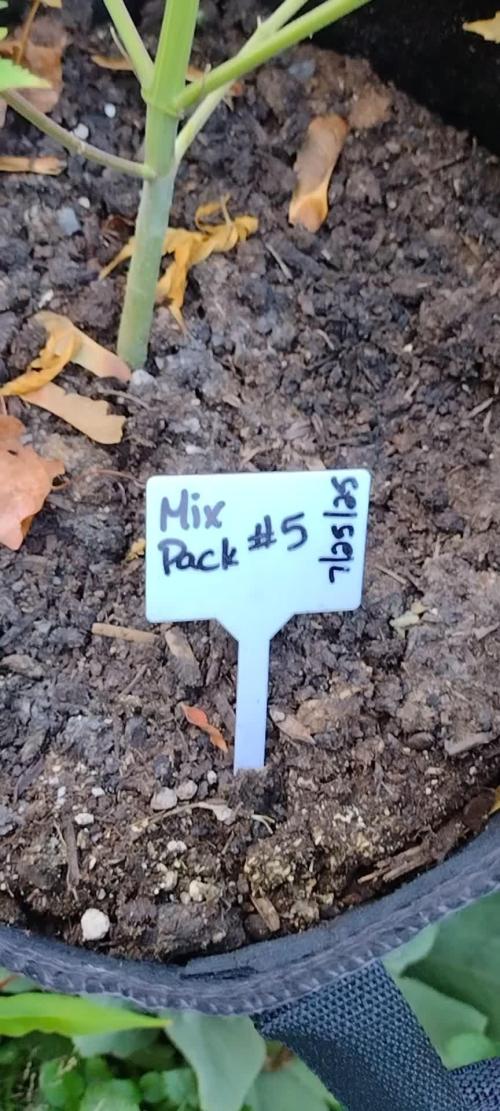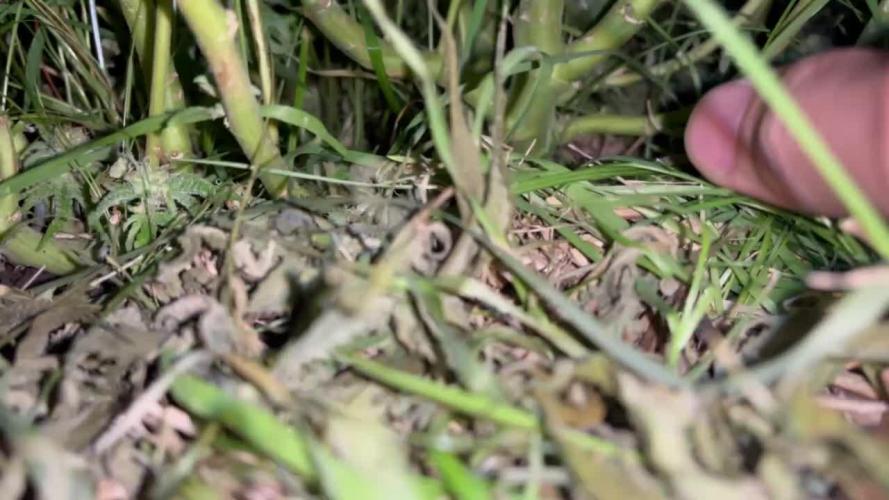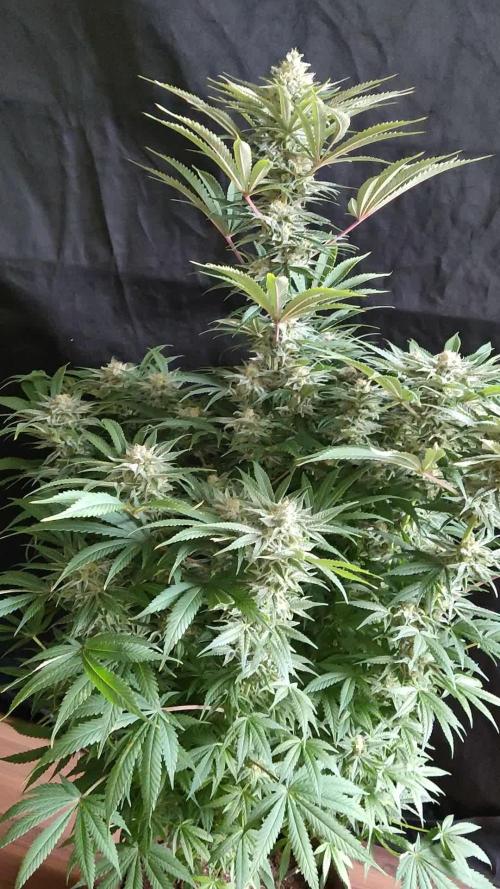The Grow Awards 2026 🏆 



































Likes
Comments
Share


@Bones_1986
Follow
Day 50
She is drinking 3 liters every 3 days.
Noticed the tips are slightly nute burn so have lowered the nutrients slightly. Bud sites filling in and swelling nicely. Very frosty.
Swapped big bud for overdrive.
Likes
6
Share


@IndigoMist8
Follow
This grow is unfortunately finished. Due to health issues I was unable to keep up with feeding and IPM and she suffered severely because of it. Infestation and bud rot took over and she is currently quarantined, finishing off her life cycle. I am testing to see if I can get any seeds from my failure as this was a frosty, strong smelling strain which I wouldn't mind trying again.
Likes
2
Share


@Baboon_Grows
Follow
5 days in flower , planted on 5/5/24.
had 3 week stunt because of pests 😂, she handled it well I’d say…
did some big defoliation today , IPM via neem & horticultural soap spray .
Also growing in my own custom mix that I recycle every grow , this is third season of the pot , with 1 season of being cycled outside ….. which I’ll never do again as I brought in all the common pests ….
Gnats taken over during first week , taken 3 weeks to get rid of them thus the stunt… poor roots
Then caterpillars -manual eradication
Then thrips - predatory mites
Then two spotted spider mites -which am still decimating , can’t see any signs of them but still be using HN spray until I start to see budding , I’ll also buy another batch of predatory mites and let them go nuts …
Ps growing in my own crafted coco coir soil . So it will only get better hopefully 😂
Likes
45
Share


@Mrs_Larimar
Follow
May, 15th 2021
Some of the Hyper Glue Plants, wich were in the smaller continers, were transplanted into 3l
They needed it, because some were yellowing,
Roots were well developed, now they can go on for a few more Weeks .
Keep Watering them with Beneficals, and Spraying one Time daily with
"Fast Plants Spray"
Thosse foliar Feeding drives them very well
Likes
55
Share


@Book_of_Thoth
Follow
So these girls are now 11 weeks old, and they are well through their flowering now. Buds are starting to swell and mature (for Red Devil and Pineapple Express more than Misty Mack), and their smells are pretty powerful. The end is approaching, and as a guideline my plan is to harvest
Pineapple Express @ 13 weeks
Red Devil @ 14 weeks
Misty Mack @ 15.5 weeks
So that means Pineapple Express' two week flush begins today.
Likes
11
Share


@Inceptionist
Follow
I guess due to the colder weather, she really starts to express her color and it's so amazing! I can't believe how beautiful this outdoor automatic is and how fast the colors are changing.
As you can see from the photo, the buds are getting a bit heavy, so I tied them back in place.
You might also see that one of the side branches, which broke during the storm, starts to let their leaves hanging. I moistened the point where the stem broke and see how she will do tomorrow. If it get's more dry, than I'm hanging it in the bathroom (which doesn't get used atm if you're wondering)
Anyways I'll trim off the leaves with no trichomes on it and give her the very last week before harvesting on Monday.
Likes
13
Share


@Gorilaweed420
Follow
Muchas gracias por dejarme participar BsF y grow diariaries y compartir este cultivo gorila glue 4. Fue un hecho en scroog en un metro veinte cuadrado usando dos masetas de 23 ltrs usanso microorganismos y productos orgánicos súper contento con esta sepa, fueron criadas con dos focos galoponeros en un armario con poco a lo q tengamos podemos hacer mucho lo importante es aprender un poco todos los días y disfrutar de nuestras cosechas un fuerte abrazo para todos @gorilaweed420
Likes
30
Share


@MrJoint
Follow
✌️🎃 Thank you for checking my cultivation.
✂️ Defoliation Time’s
🌷 Started flower stage
Likes
27
Share


@Salokin
Follow
This plant was an absolute joy to trim. This plant consisted of buds and stems only, so I am actually curious what the dry weight will be.
Likes
4
Share


@BudBeezy
Follow
Apple Strudel Auto - FastBuds
Hello welcome to my new Growdiarie, nice to see you again. Today I will start my first indoor grow and take you with me on my journey. Since I was able to gain a lot of experience through my outdoor grow this year, the first indoor grow will be much easier. The reason for this is that the parameters for an optimal grow are easy to influence.
As in the previous grows, I decided to use the water glass method for germination. After about 48 hours the seedling root formed. The germination process was carried out at a temperature of 25° Celsius near a heater.
The seedling was planted approx. 1 cm deep into the 25 liter pot. This time I used soil from Plagron. The pot was filled with Plagron Growmix. At the end I filled a hole the size of a 1l pot with Plagron Lightmix so that the seedling does not come into direct contact with the pre-fertilized soil.
Plagron Lightmix
N 180 mg/L - P 210 mg/L - K 360 mg/L
Plagron Growmix
N 216 mg/L - P 252 mg/L - K 432 mg/L
This time I will also work with fertilizer. I have two different ones to choose from. One is the mineral Plagron line (Terra Bloom, Sugar Royal, Big Bud, Greensensation) and the starter kit from Advanced Nutrients. As the soil is pre-fertilized for the first 3 weeks, it does not receive any additional fertilizer during the vegetative phase. After the first 3 weeks I decide which plant gets which fertilizer. At the end i can draw a rough conclusion as to which fertilizer series has performed better. The experiment is carried out with different varieties. I will also try tie down LST.
Set-Up:
Now a few words about my setup. I have full confidence in AC Infinity. During my research, I have only heard good things about AC Infinity. So what can I say? When the package arrived I was immediately impressed by the high quality. From the packaging to the product, everything is perfect. I ordered the lamp from kingbrite. The advantage of the lamp is that you can adjust the angle of the LED panels. The lamp is also compatible with the controller using adapter type b .
Tent: AC Infinity Cloudlab 844
Exhaust air: AC Infinity Cloudline T6 incl. activated carbon filter
Lamp: Kingbrite P55 / 480w, dimmable
Fan: AC Infinity Cloudray S6 Gen. 2
Controller: AC Infinity Controller 69 Pro
Pots: Gronest 25L
Likes
4
Share


@MyLittleGarden
Follow
Blütewoche 10: Die letzten Tage
Zeitraum: 24.07. bis 28.07.
Blütetag: 63 bis 67
Nach rund 9,5 Wochen Blüte war es so weit, Erntezeit!
Die Trichome hatten genau das Verhältnis erreicht, das ich mir gewünscht hatte. Ich hab mir meine Japansäge geschnappt und die King Juice kurzerhand am Stamm durchtrennt.
Danach hab ich sie vorsichtig samt ScrOG-Netz aus dem Zelt gehoben und sie mitten im Wohnzimmer platziert. Erst da wurde mir das ganze Ausmaß bewusst. Eine richtig große Pflanze, viele Triebe und eine Menge schöner, harziger Buds. Die Headbuds oben waren kompakt und groß, weiter unten gab’s viele kleinere Popcornbuds aber auch die waren fest und klebrig.
Nach rund 4 Stunden Trimmen hing das ScrOG-Netz wieder im Zelt, dieses Mal verkehrtherum und vollgepackt mit den einzelnen Ästen. Ein regelrechter Himmel aus Buds 😍
Die Trocknung lief optimal, Temperaturen lagen konstant bei 20–21 °C und die Luftfeuchtigkeit zwischen 54–65 %. Nach 10 Tagen habe ich die Buds am 07.08. final abgenommen.
Optik: Kompakte, daumengroße Buds, viele kleine Harzbomben mit lila Farbtönen
Geruch & Geschmack: Fruchtig, süß, würzig, pfeffrig.
Wirkung: Sie knallt gut, ist aber trotzdem klar im Kopf. Sehr angenehm!
Fazit:
Ich bin mega zufrieden mit dem gesamten Grow.
Keine Ausfälle, kaum Mängel, Temperaturen und LF meistens stabil und das Beet hat wirklich gut funktioniert. Die Pflanze hat sich wunderbar an ScrOG angepasst, und ich konnte mir damit echt einen kleinen Traum erfüllen. Eine Pflanze komplett durchziehen, schön ausgebreitet im Zelt. genau so hab ich mir das vorgestellt. Es hat richtig viel Spaß gemacht! 😊
Die Vorbereitungen für den nächsten Run laufen bereits, das Beet wird wieder frisch begrünt und ich freu mich auf den nächsten Grow!!!
Likes
18
Share


@Chubbs
Follow
420Fastbuds
Gelato Auto
Week 2
What up grow fam weekly update on these three. This week has been fun seeing the first leafs getting bigger. I started adding some GH Calimagic to my feed. I'm feeding 500ml of PH'd well water and .25 tsp/gal of some calmag about every other day. Started also my preventive maintenance of sparying PureCrop1 every Monday as the plants seem to respond well and keeps the pest away. All in all Happy Growing
Likes
79
Share


@DogDoctorOfficial
Follow
Greetings, fellow cultivators! It's time for the Week 2 Veg Report on our marvelous Epsilon F1, and let me tell you, the growth has been nothing short of spectacular. Our little green companion has truly spread its wings and embraced the journey of life.
Now, let's talk about the VIP treatment our Epsilon F1 received this week. I decided it was time for a change of scenery, so I gently transplanted her into a spacious 11 L fabric pot graciously provided by Royal Queen Seeds. Now, let's dive into the wonders of fabric pots.
Fabric pots are like a luxury spa for plant roots, allowing for optimal aeration and preventing over watering. The fabric's breathability promotes air pruning, stopping those pesky circling roots and encouraging a robust, healthy root system. It's like a tailored suit for our Epsilon F1, allowing it to grow with style and comfort.
But that's not all, my friends. During the transplant, I whipped up a magical Aptus Holland super soil mix, and oh boy, it's a nutrient symphony. Let's break it down:
Micromix Soil: This powerhouse contains a mix of microorganisms and stimulants, creating a microbial wonderland in the soil. It's like inviting the best party guests to the root zone, promoting nutrient uptake and overall plant health.
Substrate Buffer Powder: The pH magician in our mix. It conditions all substrates, ensuring a stable pH environment for our Epsilon F1. No more pH rollercoasters, just smooth sailing for our green friend.
All-in-One Pellet: The time-released 100% organic pellet fertilizer that's like a Michelin-star meal for our plant. It comes with a compounded NPK fertilizer, essential microelements, and even L-amino acids. It's the complete package for a happy, well-fed plant.
And, of course, we can't forget the star of the show, Mycor Mix! A mixture of various species of endomycorrhizae, working tirelessly to support our crop. Fixed on a vegetal carrier, it feeds and protects the fungi, creating a symbiotic relationship that's pure magic for plant growth.
Our Epsilon F1 is reacting like a rockstar to this nutrient fiesta, and I couldn't be prouder. Shout-outs to Royal Queen Seeds for the stellar genetics and the thoughtful pot, and major kudos to Aptus Holland for being the wizard behind the curtain, crafting nutrients that turn plants into botanical marvels.
Stay tuned, dear readers, as we watch our Epsilon F1 continue its journey of botanical excellence.
As always thank you all for stopping by and for supporting me on this journey, i am super passion about growing and fell blessed to have you all with me on this new journey <3 <3 <3
Genetics - RQS EPSILON F1
Ligth - LUMATEK ZEUS 465 COMPACT PRO
Food - APTUS HOLLAND
All info and full product details can be find in can find @
https://www.royalqueenseeds.com
https://aptus-holland.com/
https://autopot.co.uk/
https://lumatek-lighting.com/
With true love comes happiness <3<3<3 Always believe in your self and always do things expecting nothing and with an open heart , be a giver and the universe will give back to you in ways you could not even imagine so <3<3<3
<3 <3 <3 Growers love to you all <3 <3 <3
Likes
18
Share


@DogDoctorOfficial
Follow
Hey fellow green thumbs! 🌿💚 The day has finally come—our Auto Northern Dragon Fuel from Super Sativa Seed Club has been harvested! After an exciting journey, we’re thrilled to share the details of this incredible plant’s final stage. Let’s dive into the harvest report!
🌟 Harvest Details:
Day 75: Harvest Day
• Harvest Date: Day 75
• Harvest Method: Our beautiful Auto Northern Dragon Fuel was harvested yesterday. After weeks of careful nurturing, the time was right to bring in this amazing plant. 🌿🌼
• Preparation: Before hanging, we meticulously cleaned the plant, removing all leaves without trichomes to ensure a smooth drying process and to enhance the quality of the final product. 🌿✂️
Current Drying Process:
• Method: The entire plant is now hanging upside down to dry. This method helps maintain moisture levels within the buds, allowing for a slower and more even drying process. 🌿🔄
• Environment:
• Temperature: 18-22°C (65-72°F)
• Humidity: 50-60%
Maintaining these conditions is crucial for achieving a perfect dry and preserving the plant’s aromatic and flavorful profile. 🌡️💧
🌟 Plant and Bud Characteristics:
Auto Northern Dragon Fuel:
• Bud Structure: Dense and sticky, with an impressive trichome coverage. The buds are beautifully formed, showcasing the robust genetics of this strain.
• Aroma: Even in the drying phase, the rich and potent aroma is unmistakable. Expect a delightful scent that hints at the powerful experience to come.
• Trichomes: A thick layer of trichomes covers the buds, promising a potent final product with a great flavor profile. 🌿✨
🌟 Care Tips:
• Drying Process: Patience is key. Allowing the plant to dry slowly will enhance the final quality, preserving both flavor and potency. Ensure good airflow around the hanging plant to prevent mold and mildew. 🌬️💧
• Trimming: Once the drying process is complete (typically 10-14 days), it will be time to trim the buds. This is where we’ll shape the final product and get it ready for curing. ✂️🌿
• Curing: After trimming, curing the buds in jars for at least 2-4 weeks will further enhance the flavor and smoothness. This final step is essential for achieving the best possible smoking experience. 🍁
🌟 Genetics Spotlight:
Auto Northern Dragon Fuel:
• Characteristics: Known for its robust structure and dense buds, this strain has shown remarkable resilience and impressive bud development throughout the grow. The final product promises to be potent and flavorful, thanks to the thick trichome coverage and rich aroma.
• Harvest Expectations: High-quality buds with a strong aroma and potent effects. The slow drying process will ensure the best possible preservation of cannabinoids and terpenes.
🌍🌿 Fun Fact:
Did you know? 🌿✨ Drying the entire plant slowly helps retain more terpenes, which are responsible for the plant’s aroma and flavor. This method also helps preserve the potency and quality of the buds, resulting in a smoother and more enjoyable experience.
For all the in-depth action and detailed explanations, head over to my YouTube channel! 🎥✨ I’m sharing all the tips, tricks, and step-by-step guides to help you get the best results from your grow. This week’s harvest has been particularly exciting, and there’s so much more to explore and learn together!
👉 Join me on YouTube Link in my profile 👈
🌟 Conclusion:
Harvesting Auto Northern Dragon Fuel at Day 75 has been a rewarding experience. With the plant now drying, we’re eagerly awaiting the final product. Stay tuned for updates on the drying, trimming, and curing process, and get ready for a high-quality harvest!
Happy growing, and see you next time! 🌿💚✨
#SuperSativaSeedClub #HarvestReport #NorthernDragonFuel #PlantMagic #GardeningJoy #NatureLovers #PlantPower #InspireGrow #YouTubeJourney
Likes
25
Share


@Aleks555
Follow
Anesia Seeds - Chimera Cut💚
100 days from seed and 52 days into flowering. Everything is going well, but of course, we always strive for better! The main cola has split into three massive buds, all covered in sugar and looking incredibly beautiful. However, the lower branches don’t look as impressive, but we’re holding out hope that they’ll bulk up a bit more.
I’m considering increasing the nutrient dosage, as our girl has quite the appetite. We’re almost out of nutrients, but luckily, our favorite fertilizers from Xpert Nutrients are already on their way to us. A huge thank you to Xpert Nutrients 💚for always having our back!
Also, a big thanks to Anesia Seeds – we love your genetics! For our next grow, we’ll definitely be growing another strain from your collection.
Likes
17
Share


@Tommyweedseed
Follow
March 8-15th: This week had moderate weather with some overcast and strong winds. The Plant did not have much of a shock after transplanting and her pistols are growing in more as the days go by. She is also getting pretty tall for being on a windowsill. Going to get some Atami Bloombastic for her flowering stage and hopefully we see good results. Any advice is welcomed! 😊
Likes
38
Share


@PolishFarmer
Follow
Hi Guys! In last few days my ladies just shocked me. They growing up so quicke and i think are healthy and happy. :) so proud of them through they are higher than my last grow already :) i hang scrog gride this evening just over heads. I was forced to get rid of blue dream auto 😥 just no space in box but she do not bloomed yet the only one. Left 6 girls now and im hopefully that will stay like that to the end :) will back soon here! Bless
Likes
11
Share


@Willy_Balls
Follow
A little slow on putting up the volume. Don’t know the culprit. Co2 was elevated most of the time. Maybe the humidity was a bit too high.
















